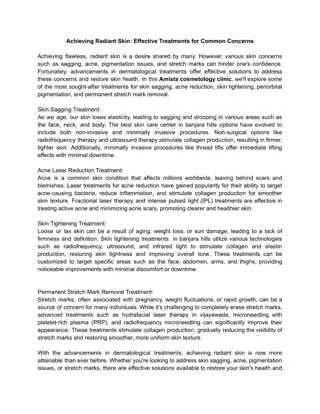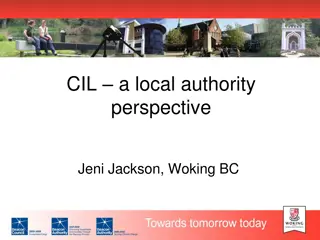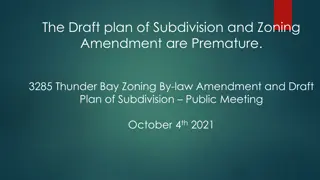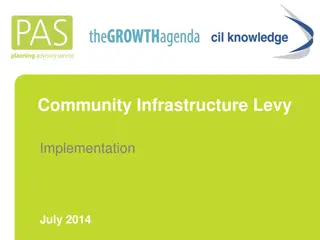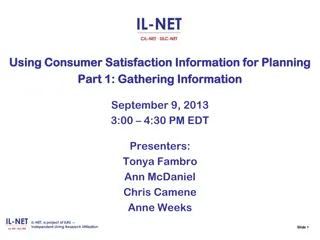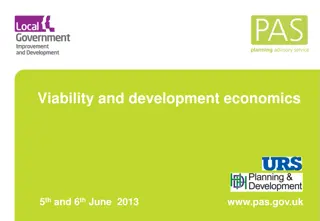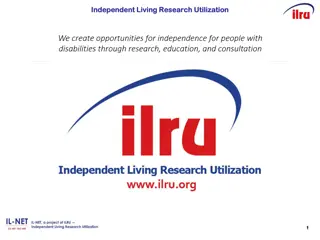
Progressing CIL Without a Plan Concerns
Progressing Community Infrastructure Levy (CIL) without a plan raises concerns about legality, risks, costs, and reputation. The content explores the views, implications, and regulatory aspects associated with implementing CIL without an up-to-date adopted plan, emphasizing the importance of evidence and compliance for charging authorities. It delves into the relevant Acts and regulations governing CIL, outlining potential challenges and considerations for decision-making.
Download Presentation

Please find below an Image/Link to download the presentation.
The content on the website is provided AS IS for your information and personal use only. It may not be sold, licensed, or shared on other websites without obtaining consent from the author. If you encounter any issues during the download, it is possible that the publisher has removed the file from their server.
You are allowed to download the files provided on this website for personal or commercial use, subject to the condition that they are used lawfully. All files are the property of their respective owners.
The content on the website is provided AS IS for your information and personal use only. It may not be sold, licensed, or shared on other websites without obtaining consent from the author.
E N D
Presentation Transcript
The Evidence Primary Evidence 1. Justification of infrastructure requirements 2. Justification of an infrastructure funding gap 3. Technical viability evidence that appraise the impact of CIL on the viability across the area as a whole 4. Proof of suitable consultation Secondary Evidence 1. Past s106 performance 2. Future approach to s106 (probably a draft SPD) 3. Regulation 123 list 4. An adopted Plan??
Progressing CIL without a Plan In 2014 the Planning Inspectorate (at a CIL event in Newcastle) gave the view: it is not necessary to have an up to date adopted plan, but that a charging authority would need up to date evidence. Planning Magazine has received the same view from PINs. A similar view has also been given by the DCLG CIL The Minister of State for Housing and Planning, Brandon Lewis, has written to a local authority in the South East stating that it is possible for a charging authority to adopt a levy in advance of its local plan provided they have robust evidence. Several Authorities are proceeding with CIL without a Plan
Progressing CIL without a Plan Concerned about the legality Risk of successful challenge or unsuccessful examination Direct cost Opportunity cost with re-allocation of resources Reputation To decide on your approach to this you need to work through the relevant Acts and regulation and status of the guidance.
Progressing CIL without a Plan Section 205 of the 2008 Act (as amended by the Localism Act 2011) sets out the purpose but does not make the link to a Plan ...(2) In making the regulations the Secretary of State shall aim to ensure that the overall purpose of CIL is to ensure that costs incurred in supporting the development of an area can be funded wholly or partly by owners or developers of land in a way that does not make development of the area economically unviable.
Progressing CIL without a Plan There is nothing in the Localism Act 2011 insisting on having a local or relevant plan, in terms of the evidence (7B)CIL regulations may make provision about the application of subsection (7A) including, in particular . a. provision as to evidence that is to be taken to be appropriate, b. provision as to evidence that is to be taken to be not appropriate, c. provision as to evidence that is to be taken to be available, d. provision as to evidence that is to be taken to be not available, e. provision as to how evidence is, and as to how evidence is not, to be used, f. provision as to evidence that is, and as to evidence that is not, to be used, g. provision as to evidence that may, and as to evidence that need not, be used, and h. provision as to how the use of evidence is to inform the preparation of a charging schedule.
Progressing CIL without a Plan In terms of the CIL Regulations 2010 (as amended) there does not appear to be anything that requires a local or relevant plan.
Progressing CIL without a Plan The link to a plan is more clear in the NPPF, but the use of the word should in this paragraph denotes advice rather than a statutory requirement. Charging schedules should be consistent with, and support the implementation of, up-to-date relevant Plans. But what is a relevant Plan ? In relation to the levy, the relevant Plan is the Local Plan in England, Local Development Plan in Wales, and the London Plan in London. Charging schedules are not formally part of the relevant Plan, but charging schedules and relevant Plans should inform and be generally consistent with each other. The National Planning Policy Framework in England (paragraph 175) provides that, where practical, charging schedules should be worked up and tested alongside the Local Plan. A charging authority may use a draft plan if they are proposing a joint examination of their relevant Plan and their levy charging schedule.
How to set CIL rates You will need to produce a CIL Charging Schedule of rates Infrastructure Requirements Viability of development Your rate(s) must be justified in 2 respects: 1. You must prove that you need infrastructure to support development and that there is an infrastructure funding gap 2. You must prove that the charge is not set at a rate that will have a significantly negative impact on development viability (i.e. the developers can t afford it) Residual Valuation (testing CIL & Affordable Housing contributions) Transport Capacity Role of new infrastructure in unlocking development Education & Health Community facilities, open space Market reaction to transition to CIL
ECONOMIC VIABILITY INFRASTRUCTURE PLANNING Infrastructure Schedule Viability Sample Sites/Uses Technical Evidence gathering phase Delivery Strategy s106 v CIL Viability on strategic sites Total Cost Estimate Total Available Funding Viability by Area Viability by Intended Use Consultant Pre- briefing for decision-makers based on best practice RATE SETTING PROCESS Establish Viability Parameters Total Funding Gap & CIL priorities Strategic Judgement Weigh up technical evidence with other local priorities: Desire for simplicity Premium placed on funding infrastructure phase Rate Setting Workshop: striking the balance Schedule of Rates
What have we learnt so far? 1. Still relatively minor component of examinations 2. All councils have an infrastructure funding gap 3. Greater emphasis on CIL vs S106 and double dipping
Infrastructure Funding Gap total cost of infrastructure funding from other sources Residual Funding Gap Aggregat e Funding Gap aggregate funding gap projected CIL Income Projected CIL Income/ CIL Target residual funding gap sources Other Total Cost of Infrastructure Funding Funding
Golden thread Relevant Plan Infrastructure Evidence Drawn from infrastructure evidence that underpins the CIL Infrastructure Evidence plan Total cost of infrastructure for projects that are potential Funding Gap Project List candidates for CIL funding Regulation 123 List Regulation 123 list Need to understand approach to S106 and S278
Waltham Forest Case Study Context Adopted Core Strategy in 2012 CS supported by SIP produced 2009 PDCS consultation based on SIP Council commissioned update to support DCS consultation Considerations Should additional infrastructure planning be undertaken for CIL? How to align plan making process to delivery?
Waltham Forest Case Study Approach additional infrastructure planning undertaken in 2013 to align IDP to spending priorities work undertaken during a 12-week intense period. update to viability work undertaken concurrently Outcomes Updated IDP that can inform capital programme Successful CIL examination in spring 2014.
Infrastructure Evidence - Questions 1. Have you identified the total cost of infrastructure they wish to fund wholly or partly through the levy? 2. In identifying your CIL target, have you considered what additional infrastructure is needed in your area to support development and what other funding sources are available? 3. Is your information on infrastructure need directly related to the infrastructure assessment that underpins your plan?
The counties role 1. Active engagement and input in the production of the Infrastructure Delivery Plans 2. Active engagement and input on identifying the infrastructure requirements for strategic sites 3. Facilitating cross border discussions on strategic infrastructure that straddles boundaries Approaches 1. Production and maintenance of county wide infrastructure plan 2. Active participation in discussions on specific strategic sites including approach on S106
Viability Analysis Maximum amount available for CIL 1,600,000 1,400,000 Financial Contribution 1,200,000 S106 1,000,000 Site value in current use 800,000 Interest 600,000 Fees 400,000 Developer's profit 200,000 Build 0 Scheme value Costs 20
Viability Evidence - Questions 1. Does the viability evidence cover the whole area 2. It the evidence appropriate & available (does it follow the Harmon report technique?) 3. Does it undertake fine grain analysis (development sites upon which the Plan relies?) 4. Does it focus on key viability issues for the area? 5. Have stakeholders been engaged (including developer and landowners) 6. Is the evidence set out in a report and has it been made public?
The counties role 1. Understanding link between s106 on strategic sites and viability for CIL. Approaches 1. Active participation in discussions on specific strategic sites including approach on S106 2. County wide viability studies

